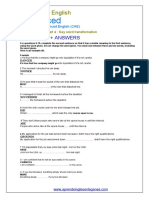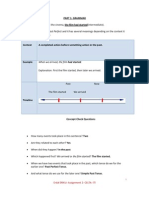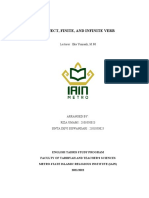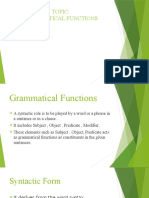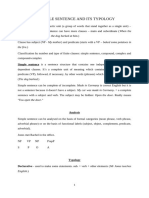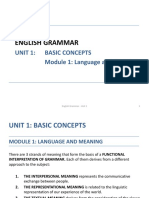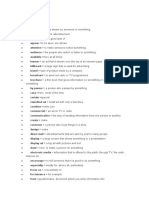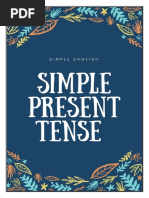English Grammar: Unit 2: The Skeleton of The Message: Introduction To Clause Structure Module 5: Subject and Predicator
English Grammar: Unit 2: The Skeleton of The Message: Introduction To Clause Structure Module 5: Subject and Predicator
Uploaded by
AmeliaCopyright:
Available Formats
English Grammar: Unit 2: The Skeleton of The Message: Introduction To Clause Structure Module 5: Subject and Predicator
English Grammar: Unit 2: The Skeleton of The Message: Introduction To Clause Structure Module 5: Subject and Predicator
Uploaded by
AmeliaOriginal Title
Copyright
Available Formats
Share this document
Did you find this document useful?
Is this content inappropriate?
Copyright:
Available Formats
English Grammar: Unit 2: The Skeleton of The Message: Introduction To Clause Structure Module 5: Subject and Predicator
English Grammar: Unit 2: The Skeleton of The Message: Introduction To Clause Structure Module 5: Subject and Predicator
Uploaded by
AmeliaCopyright:
Available Formats
ENGLISH
GRAMMAR
UNIT 2: THE SKELETON OF THE MESSAGE:
INTRODUCTION TO CLAUSE STRUCTURE
Module 5: Subject and Predicator
English Grammar - Unit 2 1
UNIT 2: THE SKELETON OF THE MESSAGE:
INTRODUCTION TO CLAUSE STRUCTURE
MODULE 5: SUBJECT AND PREDICATOR
The Subject is syntactically identified by the following features:
position, concord, pronominalisation and reflection in question
tags. Semantically, almost all participant roles can be associated
with the subject.
The Predicator syntactically determines the number and type of
Objects and Complements in a clause. It is syntactically identified
by position and concord and it is associated with a number of
semantic domains.
English Grammar - Unit 2 2
UNIT 2> MODULE 5
5.1. THE SUBJECT (S)
5.1.1. Semantic, cognitive and syntactic features
Semantic and cognitive features
– The Subject is the functional category of the clause of
which something is predicated.
– It represents the primary participant in the clause and
has the cognitive status of Topic.
– In basic clauses (finite, active and declarative) the
subject has the semantic function of Agent.
English Grammar - Unit 2 3
UNIT 2 > MODULE 5
Semantic and cognitive features
– But the subject can be associated with almost every type
of participant role.
– Examples:
Messi kicked the ball into the net (Agent)
The ball was kicked into the net (Affected in passive clause)
Paul saw a tiger near the lake (Experiencer in a mental
process)
The doctor has been given a dozen roses (Recipient in a passive
clause)
English Grammar - Unit 2 4
UNIT 2> MODULE 5
Syntactic Features
- In English, the Subject is obligatory in declarative and interrogative
clauses, but not in the imperative. When two or more clauses with the
same subject are conjoined, it can be omitted, in all but the first one.
Ex: She enterred the room, closed the door and opened the window.
-In question tags the subject is referred anaphorically by a pronoun.
Ex: His cousin is a pilot, isn’t he?
Laura didn’t mind helping you, did she?
-In declaratives and wh- questions (in which the wh- element is subject),
the subject is placed before the finite verb.
Ex: Unfortunately, everybody was gone when I arrived.
Who called you yesterday?
English Grammar - Unit 2 5
UNIT 2> MODULE 5
Syntactic Features (2)
- In yes/no questions and in wh- questions (in which the wh- element is
not subject), the subject is placed after the finite operator.
Ex: Are you happy with the exam?
What subjects are you taking this semester? (What subjects is Object)
-Subject pronouns (I, you, he, she, it, we,…) realise the subject function
whereas object pronouns (me, him, her, it, us, …) are used as Objects.
-The subject determines number (singular or plural) and person
agreement with the verb.
Ex: The student has learned the lesson.
The students have learned the lesson.
English Grammar - Unit 2 6
UNIT 2> MODULE 5
Syntactic Features (3)
-Paradigmatic contrast with a present form is applied with
verb forms that show no number or person contrast.
Ex: The time had all all passed > The time has all passed.
-Subjects determine number, person and gender agreement
with the Subject Complement, and of reflexive pronouns Cs,
Oi and Od.
Ex: John and Paula are his parents.
Why don’t you give yourselves (Od) a break?
English Grammar - Unit 2 7
UNIT 2> MODULE 5
5.1.2. Realisations of the Subject
A. Nominal Groups
These are the most prototypical function of the subject as they mainly
refer to persons and things. They can range from simple heads to
complex NG structures.
Ex: Alcohol abuse can cause liver problems.
The total amount of alcohol abuse related diseases is uncertain.
B. Dummy it
Non-referential or semantically empty use of the pronoun it that occurs in
expressions of time, weather and distance.
Ex: It’s close to midnight.
It’s snowing.
It’s seventy-two kilometres from Toledo to Madrid.
C. Unstressed there
It cannot be replaced by a pronoun but it fulfils the following criteria:
position, inversion with auxiliaries and repetition in tag questions.
Ex: There were only five people in class yesterday, weren’t there?
English Grammar - Unit 2 8
UNIT 2 > MODULE 5
5.1.2. Realisations of the Subject (2)
D. Prepositional phrase and Adverbial group as subject
It usually specifies time and place but it can also denote
instrumental meanings and idiomatic manner uses.
Ex: By Monday would be an appropriate time. (PP of time)
By bus is cheaper than by train. (PP of means)
Just over there will be a great place to sit. (AdvG of place)
E. Adjectival head
When preceded by a definite determiner, certain adjectives
that represent conventionally recognised classes of people
(the elderly) or abstractions can function as heads of (non-
prototypical) NGs.
English Grammar - Unit 2 9
UNIT 2 > MODULE 5
5.1.2. Realisations of the Subject (3)
F. Embedded clauses
Both finite and non-finite clauses are subject of embedding.
- Types of finite clauses: that-clauses and wh-clauses (nominal or
relative).
Ex: That he didn’t accept the job surprised everyone. (that-clause)
Why the bank closed for the week was not explained (wh-
interrogative)
What she did shocked me (wh-nominal clause)
The fact that he didn’t accept the job surprised everyone. (NG)
- Types of non-finite clauses: to-infinitive and –ing clauses.
Ex: To do all the work at once was rather stupid. (to-inf. clause)
What to do with the kids is the problem. (wh- + to-inf. clause)
Having to return for the papers was a hassle.
Call his parents home was what he did. (bare infinitive clause)
English Grammar - Unit 2 10
UNIT 2 > MODULE 5
5.1.2. Realisations of the Subject (4)
G. Anticipatory it + extraposed subject
Extraposition is frequent in speech and writing, especially to avoid
long and heavy subjects.
Ex: It was surprising that you mentioned that.
- Extraposed subjects can be the complement of a noun or
adjective SPCs structures.
Ex: It’s easy to miss a class. (To miss a class is easy)
It’s a pity that you are not going to attend the party. (That
you are not going to attend the party is a pity)
- Extraposition is obligatory in clauses with it + verbs of seeming
(seem, appear) and happening (happen, turn out).
Ex: It seems that they were fine after all. (*That they were fine
after all seems).
It so happened that the pilot lost the race. (*That the pilot lost
the race happened).
English Grammar - Unit 2 11
UNIT 2> MODULE 5
5.2. THE PREDICATOR (P)
The Predicator is present in all major types of clause, including the
imperative. It may be transitive, intransitive or copular.
-It may constitute the whole of the predicate as in The students arrived in
Paris.
-It is identified by its position in relation to the subject.
-Its function is realised by both finite (e.g. sees) and non-finite (seeing) lexical
and primary verbs.
-In functional terms, finiteness is usually carried out by an auxiliary verb, such
as has, had, to specify tense and voice (be + gerund/past participle) and then
followed by the predicator (is cooking, was cooked).
-Semantically, it encodes the following types of process:
•Material processes of “doing” (make, catch, go);
•Mental processes of “experiencing”, with verbs of perception (see),
cognition (know), affectivity (like) and desideration (hope); and
•Relational processes of “being” (be, belong).
English Grammar – Unit 2 12
You might also like
- 70 Cae Key Word Transformations + AnswersNo ratings yet70 Cae Key Word Transformations + Answers7 pages
- English Grammar: Unit 1: Basic ConceptsNo ratings yetEnglish Grammar: Unit 1: Basic Concepts20 pages
- English/Filipino: Independent Study Plan and Resources For Seventh GradeNo ratings yetEnglish/Filipino: Independent Study Plan and Resources For Seventh Grade15 pages
- Unit 1. Lesson 6. The Best Days of Your LifeNo ratings yetUnit 1. Lesson 6. The Best Days of Your Life4 pages
- English Grammar: Unit 2: The Skeleton of The MessageNo ratings yetEnglish Grammar: Unit 2: The Skeleton of The Message12 pages
- Subject, Finite and Infinite Verb. Advance Grammar and StructureNo ratings yetSubject, Finite and Infinite Verb. Advance Grammar and Structure14 pages
- Engl 412 Advanced descriptions of Modern English.No ratings yetEngl 412 Advanced descriptions of Modern English.45 pages
- Sophmore English Unit 2: Sentence CombinationNo ratings yetSophmore English Unit 2: Sentence Combination154 pages
- SLM-I Sem English-Functional Grammar and Communication in English (Scrutinized Final Draft)No ratings yetSLM-I Sem English-Functional Grammar and Communication in English (Scrutinized Final Draft)265 pages
- English Grammar: Unit 2: The Skeleton of The MessageNo ratings yetEnglish Grammar: Unit 2: The Skeleton of The Message15 pages
- Phrases, Clauses, & Sentence Structure: Unit TwoNo ratings yetPhrases, Clauses, & Sentence Structure: Unit Two29 pages
- Modern English, Exercises For Non-Native Speakers, PART II - Sentence & Complex StructuresNo ratings yetModern English, Exercises For Non-Native Speakers, PART II - Sentence & Complex Structures3 pages
- Grammar Seminar Theory - 1-L. Introduction Branches of LinguisticsNo ratings yetGrammar Seminar Theory - 1-L. Introduction Branches of Linguistics11 pages
- Preparacion de Profesores de Ingles en El Tecnico en Ingles1No ratings yetPreparacion de Profesores de Ingles en El Tecnico en Ingles126 pages
- Trabalho de Ingles-1-Sardio Dos Santos RamalhoNo ratings yetTrabalho de Ingles-1-Sardio Dos Santos Ramalho11 pages
- Bahasa Inggris II Introduction To Structure and Written ExpressionsNo ratings yetBahasa Inggris II Introduction To Structure and Written Expressions1 page
- 2405 Unit 2-Phrases, Clauses, Sentence StructureNo ratings yet2405 Unit 2-Phrases, Clauses, Sentence Structure29 pages
- Structures of Modification in Narrative TextsFrom EverandStructures of Modification in Narrative TextsNo ratings yet
- Higher Lessons in English: A work on English grammar and compositionFrom EverandHigher Lessons in English: A work on English grammar and composition1/5 (3)
- Booklet - Inglés 6º CEIP Federico García LorcaNo ratings yetBooklet - Inglés 6º CEIP Federico García Lorca59 pages
- English Grammar: Unit 2: The Skeleton of The MessageNo ratings yetEnglish Grammar: Unit 2: The Skeleton of The Message8 pages
- English Grammar: Unit 2: The Skeleton of The MessageNo ratings yetEnglish Grammar: Unit 2: The Skeleton of The Message19 pages
- Special Features of Legal English-39335093No ratings yetSpecial Features of Legal English-3933509313 pages
- Cat Tools: An Introduction: Montserrat Bermúdez BauselaNo ratings yetCat Tools: An Introduction: Montserrat Bermúdez Bausela30 pages
- Unit 5. Stress and Rhythm: A Theoretical ApproachNo ratings yetUnit 5. Stress and Rhythm: A Theoretical Approach13 pages
- English Grammar: Unit 1: Basic Concepts Module 1: Language and MeaningNo ratings yetEnglish Grammar: Unit 1: Basic Concepts Module 1: Language and Meaning10 pages
- English For Law (& Its Translation) Bibliography PDFNo ratings yetEnglish For Law (& Its Translation) Bibliography PDF14 pages
- Vocabulary - Phrasal Verbs Time and Change 17.02.2015No ratings yetVocabulary - Phrasal Verbs Time and Change 17.02.20151 page
- Vocabulary - Belief and Opinion: Phrases For Expressing OpinionNo ratings yetVocabulary - Belief and Opinion: Phrases For Expressing Opinion2 pages
- Feelings: The Effect of The Weather On Our FeelingsNo ratings yetFeelings: The Effect of The Weather On Our Feelings2 pages
- Name: Muhammad Anas Bin Ismail Matric No: 2019801934 Class: Apt3JfNo ratings yetName: Muhammad Anas Bin Ismail Matric No: 2019801934 Class: Apt3Jf5 pages
- Philebus Greek Text and Basic Grammar 2n PDFNo ratings yetPhilebus Greek Text and Basic Grammar 2n PDF333 pages
- To Live and Work in Germany, You Have To Start Here!No ratings yetTo Live and Work in Germany, You Have To Start Here!7 pages
- Commonly Misused Words and Confusingly Related WordsNo ratings yetCommonly Misused Words and Confusingly Related Words3 pages
- 5 Reflexive Demonstrative and Indefinite PronounsNo ratings yet5 Reflexive Demonstrative and Indefinite Pronouns29 pages
- Roots and Affixes: How Words Are CreatedNo ratings yetRoots and Affixes: How Words Are Created14 pages
- Complete Download French in Paris 1 2nd Edition Romain Rannou PDF All Chapters100% (6)Complete Download French in Paris 1 2nd Edition Romain Rannou PDF All Chapters81 pages
- English/Filipino: Independent Study Plan and Resources For Seventh GradeEnglish/Filipino: Independent Study Plan and Resources For Seventh Grade
- English Grammar: Unit 2: The Skeleton of The MessageEnglish Grammar: Unit 2: The Skeleton of The Message
- Subject, Finite and Infinite Verb. Advance Grammar and StructureSubject, Finite and Infinite Verb. Advance Grammar and Structure
- SLM-I Sem English-Functional Grammar and Communication in English (Scrutinized Final Draft)SLM-I Sem English-Functional Grammar and Communication in English (Scrutinized Final Draft)
- English Grammar: Unit 2: The Skeleton of The MessageEnglish Grammar: Unit 2: The Skeleton of The Message
- Modern English, Exercises For Non-Native Speakers, PART II - Sentence & Complex StructuresModern English, Exercises For Non-Native Speakers, PART II - Sentence & Complex Structures
- Grammar Seminar Theory - 1-L. Introduction Branches of LinguisticsGrammar Seminar Theory - 1-L. Introduction Branches of Linguistics
- Preparacion de Profesores de Ingles en El Tecnico en Ingles1Preparacion de Profesores de Ingles en El Tecnico en Ingles1
- Bahasa Inggris II Introduction To Structure and Written ExpressionsBahasa Inggris II Introduction To Structure and Written Expressions
- Structures of Modification in Narrative TextsFrom EverandStructures of Modification in Narrative Texts
- Higher Lessons in English: A work on English grammar and compositionFrom EverandHigher Lessons in English: A work on English grammar and composition
- English Grammar: Unit 2: The Skeleton of The MessageEnglish Grammar: Unit 2: The Skeleton of The Message
- English Grammar: Unit 2: The Skeleton of The MessageEnglish Grammar: Unit 2: The Skeleton of The Message
- Cat Tools: An Introduction: Montserrat Bermúdez BauselaCat Tools: An Introduction: Montserrat Bermúdez Bausela
- English Grammar: Unit 1: Basic Concepts Module 1: Language and MeaningEnglish Grammar: Unit 1: Basic Concepts Module 1: Language and Meaning
- English For Law (& Its Translation) Bibliography PDFEnglish For Law (& Its Translation) Bibliography PDF
- Vocabulary - Phrasal Verbs Time and Change 17.02.2015Vocabulary - Phrasal Verbs Time and Change 17.02.2015
- Vocabulary - Belief and Opinion: Phrases For Expressing OpinionVocabulary - Belief and Opinion: Phrases For Expressing Opinion
- Feelings: The Effect of The Weather On Our FeelingsFeelings: The Effect of The Weather On Our Feelings
- Name: Muhammad Anas Bin Ismail Matric No: 2019801934 Class: Apt3JfName: Muhammad Anas Bin Ismail Matric No: 2019801934 Class: Apt3Jf
- To Live and Work in Germany, You Have To Start Here!To Live and Work in Germany, You Have To Start Here!
- Commonly Misused Words and Confusingly Related WordsCommonly Misused Words and Confusingly Related Words
- Complete Download French in Paris 1 2nd Edition Romain Rannou PDF All ChaptersComplete Download French in Paris 1 2nd Edition Romain Rannou PDF All Chapters


